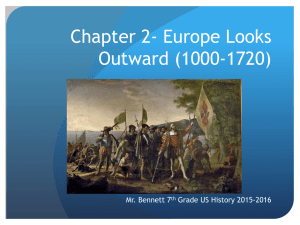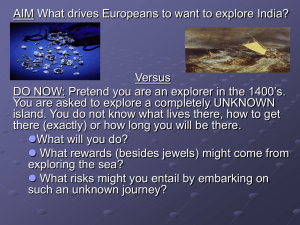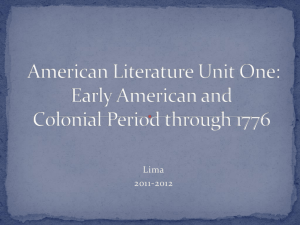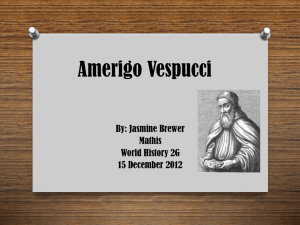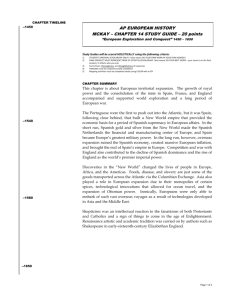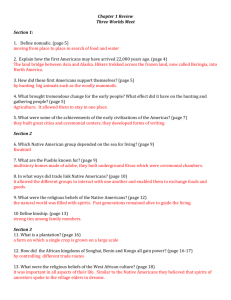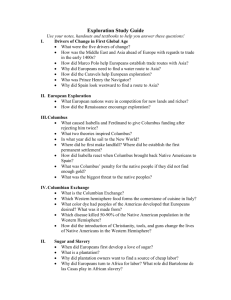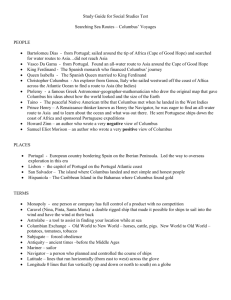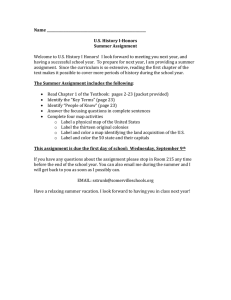Unit One: “The New World”—NP 1-3
advertisement
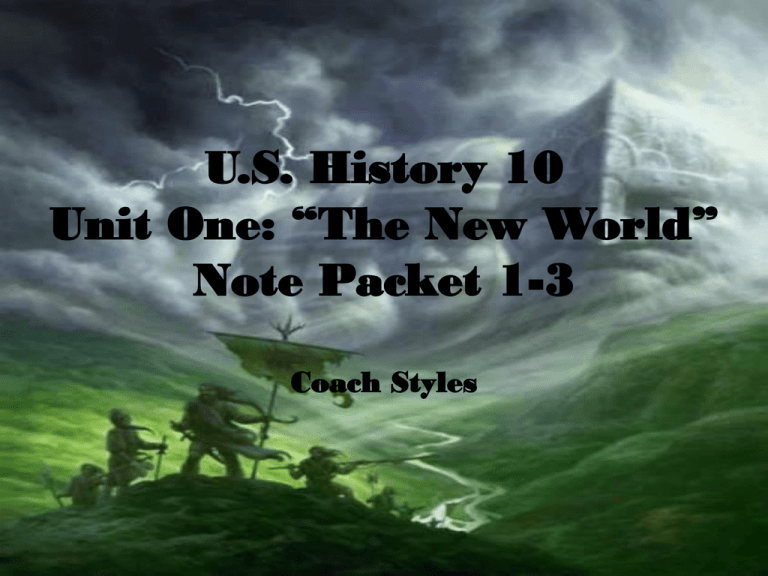
U.S. History 10 Unit One: “The New World” Note Packet 1-3 Coach Styles Unit One: “The New World”—N.P. 1-3 • For hundreds of years, great civilizations were abounding in the Americas without the knowledge of the Europeans. • The Europeans themselves were, for much of the time (500 to 1400), isolated from the rest of the world. • This period of time is referred to as what? • Middle Ages • There were, however, some Europeans who did break out of the isolationist shell and search beyond their present borders. Unit One: “The New World”—N.P. 1-3 • The Vikings (Norsemen) were the first European explorers. • Around 500 yrs. Before Columbus set sail • It is likely that the Vikings reached the Faeroe Islands by 800 and Greenland around the year 870. Unit One: “The New World”—N.P. 1-3 • But the very first “Old World” dweller to lay eyes on the North American continent was most likely a Norseman named Bjarni Herjulfsson in 986. • Probably a mistake in navigation as he had no real interest in exploring the land he sighted. But in the next decade, the son of the notorious Viking known as “Eric the Red” … • In 1000, Norse captain Leif Eriksson—known as “Leif the Lucky”—led an expedition to 3 main locations: Unit One: “The New World”—N.P. 1-3 1. Helluland (meaning “flat land”): Baffin Island (Canada) 2. Markland: Labrador (Canada) 3. Vinland: Newfoundland (so named because Eriksson and his men spent a winter there in crude Viking huts erected on a spot abundant with berries and grapes. Unit One: “The New World”—N.P. 1-3 • Although “Leif the Lucky” left Vinland, his brother, Thorvald, came again about 4 years later. • In about 1010, Norseman Thorfinn Karlsefni attempted to establish a permanent settlement at Vinland. • Thorfinn and his crew carried on a lively trade, but also fought fiercely with the Native Americans of the region. After 3 lethal winters… • The Native Americans, known by the Vikings as “skraelings” (meaning “savages” or “screechers”) repeatedly attacked, forcing the Vikings to abandon Vinland forever. Unit One: “The New World”—N.P. 1-3 • Ultimately, the Viking expeditions to the New World led to nothing. • For almost 500 years, no further European contact was made in the New World across the “Ocean Sea” of the Atlantic Ocean. • Consider the long timeline of European history: • The expansiveness of classical Greek and Roman civilization—when great minds (Plato, Aristotle, Socrates) speculated freely on the open nature of the entire universe—and the armies of empire ranged across the known world—followed by an era of contraction. • The Middle Ages (sometimes referred to as the “Dark Ages”): Period of time between the fall of the Roman Empire and the Renaissance—marked by European seclusion and isolation. Unit One: “The New World”—N.P. 1-3 Unit One: “The New World”—N.P. 1-3 • Questions from Video Clip: 1. Black Death: (Bubonic Plague): Wiped out 25% of Europe’s population, resulting in a labor shortage that led to the decline of feudalism (def): Economic and political system in which leaders gave land to nobles in exchange for loyalty, and serfs working the land in exchange for a share of the crops. • The decline of feudalism led to the period known as… 2. Renaissance: Period of “rebirth” (14th-16th century), in which Europeans were filled with a new curiosity of the outside world and intense desire for knowledge. • One of the most important inventions of the period was Johannes Gutenberg’s printing press, enabling the cheap mass production of books and unleashing the progress of expanded thought and exchange of information. Unit One: “The New World”—N.P. 1-3 • Questions from Video Clip (cont): • Four main factors leading to the Age of Exploration: 1. Increase in trade 2. Increase in the desire to learn about the outside world 3. Important inventions 4. Rapid flow of ideas and information • These developments would eventually transform life in all parts of the world. Unit One: “The New World”—N.P. 1-3 • Following Gutenberg’s printing press (first used to mass produce the Holy Bible, the progress of thought was unstoppable. • But there was another explanation for the desire of Europeans to seek to venture beyond their borders: Europe was getting cramped. • Renaissance Europeans wanted to get out into a bigger world. • Whereas traditional European society had been divided into a tiny aristocracy and vast peasantry, a new middle class of merchants appeared on the scene. • The survival and prosperity of the merchants depended on new and greater sources of import goods as well as markets for domestically produced goods. • Supply and demand within Europe was limited. Unit One: “The New World”—N.P. 1-3 • Since the days of the Crusades, Europeans demand grew for products they could not produce for themselves. • Demand grew for products such as: Sugar, glass, and steel from Damascus; rugs from Persia; pepper from India; clove, cinnamon, and nutmeg from the Spice Islands • To pay for these goods, Europeans sent wool, tin, gold, and silver along the old trade routes. Unit One: “The New World”—N.P. 1-3 • The old trade routes had always been very difficult, dangerous, expensive, and time-consuming. • Months and even years passed before a box of spices or a bole of cloth reached Europe from Asia. • Camel caravans carrying products over land from China and central Asia crossed vast desert wastelands and high mountain passes. Unit One: “The New World”—N.P. 1-3 • Goods moving from the East Indies along the sea-land route made a long sea voyage across the Indian Ocean—then goods were carried over the burning Arabian desert by camel caravans. Next came another sea voyage , this time across the Mediterranean Sea on ships bound for Italy. Italian merchants had a monopoly on trade between the eastern Mediterranean and Europe. Unit One: “The New World”—N.P. 1-3 • Monopoly (def): Exclusive control over the supply of a product or service—free from competition. • Finally, Asia’s highly demanded products reached Europe’s markets. • Many European merchants wanted to get Asia goods cheaper and end the monopoly of the east-west trade held by the Italians in Genoa and Venice. • Consequently, the growing demand for products from the Far East had a direct bearing on the arrival of European explorers in America. • WHAT WAS THE MAIN FACTOR LEADING TO THE DISCOVERY OF AMERICA? • The main factor leading to the discovery of America was the search for new trade routes between Europe and Asia. Unit One: “The New World”—N.P. 1-3 • The Portuguese, the Spanish, and the Dutch began to search for new ocean routes to Asia. • So, while the now-famous Christopher Columbus was still a young boy in Genoa, Italy, the search for a new, all-water route between Europe and Asia was already well under way. • Portugal began the search for an all-water route to Asia. • Portuguese sailors, were financed by Prince Henry of Portugal (known as Prince Henry the Navigator). • On the coast of Portugal, Prince Henry built a shipyard (which constructed ships seaworthy enough to brave the open waters of the Atlantic Ocean) and a school for navigators. • Portuguese sailors focused on the African shoreline for their sea route to the Far East…and with every expedition, pushed further and further south until in… Unit One: “The New World”—N.P. 1-3 • 1488: Bartholomew Diaz rounded the tip of southern Africa—his crew refused to go further. • 1498: Vasco de Gama, following the route of Diaz, rounded the Cape of Good Hope and continued across the Indian Ocean to Calcutta, India. • Voyages of Diaz and de Gama important to Portugal and the world. • Within a few years, Portuguese vessels sailed back and forth along this new, all-water route to India and the Spice Islands. Unit One: “The New World”—N.P. 1-3 • While the Portuguese sailors were exploring the coast of Africa in search of a shorter trade route to India, Spain had something different in mind. • Columbus falsehoods • The idea of a round earth was hardly new by the end of the 15th century. • Ancient Greeks (Pythagoras/Aristotle) noted that the earth was a sphere and even in the 3rd century, B.C., Eratosthenes of Cyrene performed a remarkably accurate measurement of the earth’s circumference. Unit One: “The New World”—N.P. 1-3 • Christopher Columbus (Native Italian—Christoforo Columbo • Born in Genoa, Italy in 1451 • Illiterate until adulthood, but had a curious, open mind • As a youth, he took to the sea. • In 1476, shipwrecked off Portugal, he went to Lisbon, then sailed as far as Ireland and England—claimed to have sailed from England to Iceland, where he heard stories of an ancient place called Vinland, far across the “Ocean Sea.” Unit One: “The New World”—N.P. 1-3 • Columbus married at 30, but wife died giving birth to his son, Diego. • Having finally learned to read, he devoured every available account of westward voyages. • Refused funding voyages by rulers of Portugal/Medina • Persuaded King Ferdinand and Queen Isabella of Spain to fund his voyage westward in search of a better trade route to the Far East and “earnestly desirous of taking Christianity to heathen lands.” • Under the flag of Spain, Columbus set sail on August 3, 1492, commanding 3 ships: 1. Nina 2. Pinta 3. Santa Maria (Columbus’s flagship) Unit One: “The New World”—N.P. 1-3 • During its first month and a half, the voyage went well, as the 3 ships were propelled by very favorable winds. • However, between September 20th and 30th, the winds turned bad and the ships were pummeled by storms. • Food and water scarce, the crews began to doubt the success of the voyage. • By the end of the second week of October, Columbus’s crew verged on mutiny. • Mutiny (def): Revolt against a commanding authority. • Columbus begged for another day of sailing west. • October 12, 1492: A lookout aboard the Santa Maria spotted land (not the expected Asia, but an island in the Bahamas that Columbus named San Salvador, meaning “Holy Savior”). Unit One: “The New World”—N.P. 1-3 • Columbus and his crew were greeted by friendly Arawak tribes people. • Believing he had reached Asia (the Indies), Columbus called these people “Indians.” Unit One: “The New World”—N.P. 1-3 • Columbus tried again and again and still again (a total of 4 voyages) to find an all-water route to Asia, but he failed. • He returned from his 4th voyage a poor, lonely, broken-hearted man— dying in 1506 without the knowledge that his voyages would, in time, have a deep and lasting impact on the entire world. • Columbus’s journeys began a new era of transatlantic trade known as the Columbian Exchange (def): The exchange of goods, foods, and technologies between Europe and the Americas. • New foods from America: peanuts, pineapples, tomatoes, cocoa, and potatoes (which quickly became the new food for Europe’s poor, saving a vast number of lives in times of famine). • Native Americans began raising animals brought from Europe, such as chickens, cattle, and horses; They also learned how to work with iron to make tools. Unit One: “The New World”—N.P. 1-3 • The “Indians” taught Europeans hunting skills suitable to the American land and Europeans benefitted from learning about Native American medicine. • The Columbian Exchange was far from being all positive: • Native Americans had no resistance to the diseases the Europeans brought to the Americas, such as typhus, smallpox, and measles. • Disease spread rapidly along the extensive Native American trade network, killing thousands of Indians. • Europeans were initially unaware they were passing the diseases. • Many Europeans believed that the massive death of Native Americans was a sign that God favored Europeans over Indians and that they had the right to conquer the new land. Unit One: “The New World”—N.P. 1-3 • Following the voyages of Columbus, the Portuguese launched a series of expeditions to the New World. • Even though the Portuguese crown failed to bankroll the voyages of Columbus, they believed it was Portuguese technology that made his voyages possible, thereby feeling they should have claims to his discoveries. • European Catholics believed the Pope had the authority to divide any newly-conquered, non-Christian lands. • 1494: Under pressure from Pope Alexander VI, Portugal and Spain sign the Treaty of Tordesillas, which established the Line of Demarcation (def): An imaginary line around the world that divided the New World between Spain and Portugal. Unit One: “The New World”—N.P. 1-3 • Spain was granted all land west of the line (included most of the Americas) • Portugal was granted all land east of the line (included part of Brazil and the sea route to Asia) Unit One: “The New World”—N.P. 1-3 • Why are we not called the United States of Columbia? • 1501: A Florentine explorer, Amerigo Vespucci (on behalf of Portugal), discovered what is now Brazil and Venezuela. • Vespucci claimed to have made 4 Atlantic voyages between 1497 and 1504, though only 2 have been confirmed. • Following the 1501 voyage, Vespucci coined the phrase “Mundus Novus,” meaning “New World.” • In 1507, a German map maker published an account of Vespucci’s voyages, along with a map. • He then used a Latinized form of Vespucci’s first name to label the region Vespucci explored— “America.”
